Late December 2019 saw a cluster of pneumonia cases with unknown aetiology in Wuhan city, the capital city of Hubei province in China, which soon turned into a large outbreak and within a couple of weeks into a pandemic [1]. In fact, the Chinese Center for Disease Control and Prevention identified a novel type of coronavirus as the causative agent responsible for this pneumonia outbreak on 9th January, 2020, soon after that the number of confirmed cases rose to 9,700 within a short time span in China; and 106 in 19 different countries, than the World Health Organisation (WHO) declared this outbreak a public health emergency of international concern on 30th January, 2020 [2].
The disease caused by the new virus, found to be a serotype of Severe Acute Respiratory Syndrome (SARS)- coronavirus, was designated as COVID-19 or coronavirus disease-2019 on 11th February 2020 by WHO [3]. This highly contagious disease caused by the newly emerged coronavirus, which has spread from China and then as a pandemic has caused unprecedented human health and economic consequences across the world and continues to unfold the loopholes in the medical systems. This virus affected the lives and livelihoods of the people among almost all the countries of the world [4]. India was not any exception to this scenario, where the first laboratory-confirmed case of COVID-19 was reported in Kerala on 30th January 2020 and after that continued to rise at a fast rate despite continuous efforts by the healthcare institutions and government agencies [5]. According to the Center for Disease Control (CDC, USA), virus transmitted via droplets and fomites has spread in very short period of time. The main modes of transmission of Coronavirus are person to person contact, household transmission and by contact with infected surfaces or objects [6].
The government and different communities have been working day and night worldwide to gain control over the situation and also to limit the spread of this virus; social distancing was thought to be helpful in limiting the spread of this virus, and consequently, the Indian government announced its first lockdown on 24th March 2020 in the country to limit the spread of infection and to prevent the spread of cluster outbreaks by restricting the movement of people in a country with a population of approximately 1.3 billion, where public has been asked to stay at home as much as possible and to promote teleworking culture in order to reduce the person to person contact [7].
All private and government sectors organisations have been affected by the restrictions imposed during the lockdown; social, personal and professional lives of almost every individual has been affected in one way or the other; including the student life of many throughout the country (India), the second largest education system in the world after China. With the progressive spread of COVID 19, like wildfire, all the educational institutions were closed in accordance with the country’s lockdown policies, aimed at prevention of disease spread [8]. Schools and colleges in India have been solely practicing classroom teaching since a long time and include a one to one interaction between students and teachers. The ongoing coronavirus crisis has therefore affected the lives of students to a huge extent, where they are unable to interact with their teachers/guides on a one to one basis [9]. Learning being a continuous process, must not be affected by this pandemic scenario and therefore, many educational institutions have been forced to suddenly transform from classroom teaching to online teaching forums to keep the learning process on the go [10]. In education system, this shift from traditional classroom teaching to online learning might be one of the largest educational experiments till now [11]. Various educational organisations have come forward to introduce a wide variety of platforms to facilitate increased participation in online teaching-learning projects [12,13]. Consequently, more and more students now have access to the facilities to move forward towards their educational and professional aims while being safe from their own premises [14].
Online learning has several advantages over traditional classroom learning. Besides less use of paper, man hours saved with easy and quick access to a wide source of information, it also gives a big advantage of studying anywhere anytime with more flexibility. Despites many advantages, it has several limitations too. Things taught through online modules are more challenging both for the educator as well as the learner [12,15,16]. As the online teaching-learning process becomes more prevalent in India due to COVID-19 pandemic, seems that very soon the digital learning system will be the new face of Indian education. So, it is particularly essential to assess its growth or to know if it meets the student’s expectations. The present study was therefore, designed in a way to understand the effectiveness, student’s perspective and readiness about online classes being conducted at the university level.
Materials and Methods
A questionnaire based observational descriptive study was conducted at SGT University, Gurugram among the students of four different universities i.e., Punjabi University Patiala, Baddi University Solan, SGT University and GD Goenka University Gurugram. Data was collected from April 2020 to May 2020. The ethical clearance was exempted as the study was conducted during the lockdown period.
Inclusion criteria: The random selection of participants was done in order to conduct the online survey based on the following criteria: a student of graduation or postgraduation, aged 17 years or more, studying in a professional course, possessing basic knowledge of computer or online technology and, attending the online classes.
Exclusion criteria: Students, who did not have any knowledge of online technology, age less than 17 years and not attending online classes were excluded.
Sample size calculation was done using G- power software. A total of 400 students from four different Indian universities participated in the study. Out of 400 students, 131 from GD Goenka University, Gurugram; 128 from SGT University, Gurugram; 112 from Baddi University, Himachal Pradesh and 29 from Punjabi university Patiala were included.
A semi-structured, self-administered questionnaire was developed in English language and prepared in the form of Google docs. Questions were multiple response or single response type [9]. It was framed to inquire respondents’: perception regarding online classes, reason for liking or disliking the online classes, choice of source and platform for e-learning, perspective regarding e-learning and it’s future scope. The online link of the questionnaire was sent to the students either through an e-mail or a WhatsApp message.
Statistical Analysis
The raw data which was obtained through survey was analysed using the Statistical Package for the Social Sciences (SPSS) version 20.0 (SPSS Inc., Chicago, IL, USA) for statistical analysis and the results were calculated.
Results
A total of 400 students (Physiotherapy, BAMS, Pharmacy and Nursing) filled the questionnaire and submitted their response. The Mean age of the total enrolled sample population was 20.35±2.10 years. Out of 400 students; 157 (39.25%) were males and 243 (60.75%) were females, respectively.
When asked about the student’s perception regarding online classes or e-learning during lockdown, 221 (55.25%) students opined that they liked studying through online classes whereas 179 (44.75%) did not like e-learning.
When asked about reason for liking and disliking online classes; 31.5% liked online teaching because of flexible study time, 24% due to flexible study location, 23% for no need to visit the campus and 9.5% as face to face interaction will become limited [Table/Fig-1].
Frequency percentage distribution for liking online classes.
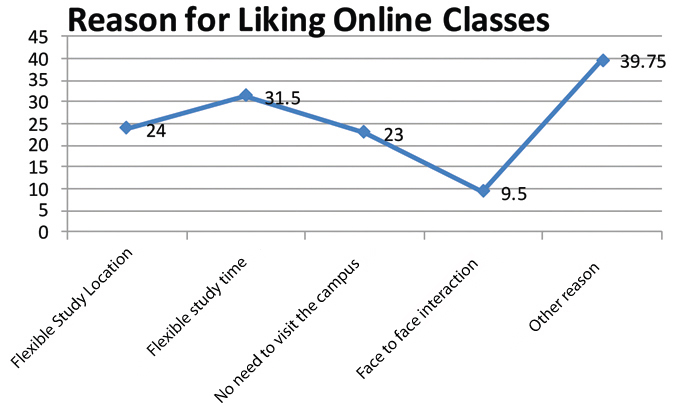
A 17.5% disliked online classes because of no co-curricular activities at home, 38.25% due to no practical classes, 15.25% no group study, 20% lack of two-way communication, 20.25% lack of demonstration, 43.5% net connectivity issue and 19.75% due to lack of free flowing conversations/debates/discussions [Table/Fig-2].
Frequency percentage distribution for disliking online classes.
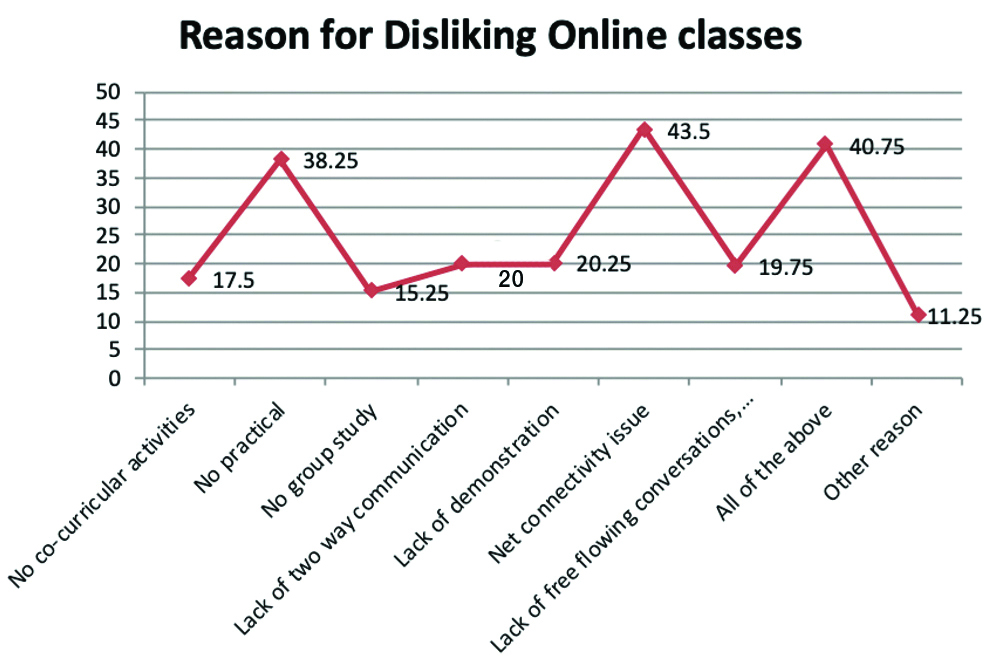
As a choice of the source for online classes 172 (43%) students preferred notes, 189 (47.25%) PPT with audio, 134 (33.5%) videos, 148 (37%) webinar or video conferencing and 112 (28%) choose PPT [Table/Fig-3].
Frequency of choice of the source for e-learning.
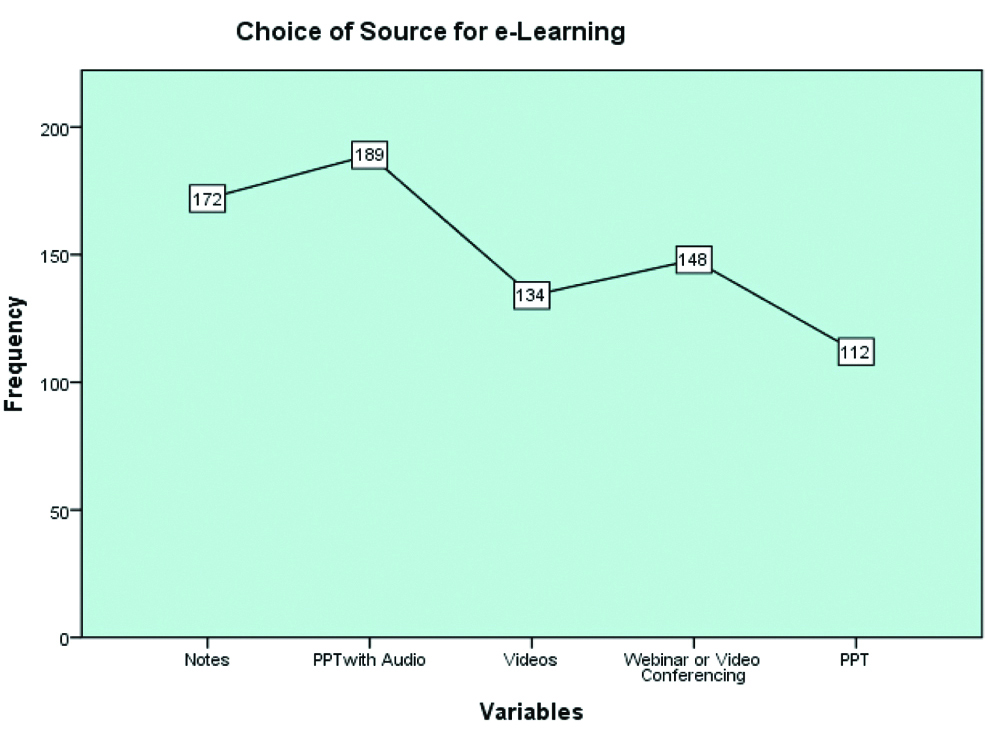
Regarding student’s satisfaction with online classes it was rated as completely unsatisfied, mostly unsatisfied, somewhat unsatisfied, somewhat satisfied, mostly satisfied and completely satisfied, respectively [9]. After analysis of the result, it was found that 8.25% were completely unsatisfied, 19.75% were mostly unsatisfied, 27.25% were somewhat unsatisfied, 24.5% were somewhat satisfied, 13.75 were mostly satisfied and 6.5 were completely satisfied [Table/Fig-4].
Frequency distribution of satisfaction level of satisfaction with online classes.
| Satisfaction level | n | % |
|---|
| Completely unsatisfied | 33 | 8.25 |
| Mostly unsatisfied | 79 | 19.75 |
| Somewhat unsatisfied | 109 | 27.25 |
| Somewhat satisfied | 98 | 24.5 |
| Mostly satisfied | 55 | 13.75 |
| Completely satisfied | 26 | 6.5 |
| Total | 400 | 100 |
A 90.5% students thought that classroom teaching was the preferred choice platform for better learning whereas only (9.5%) selected online teaching.
When students were asked about perception regarding online classes; 32.25% students responded by saying yes that online teaching is an effective practice for discussion forum while 67.75% said no, 41% said that dynamic knowledge was enhanced by online platform while 59% did not agree, 37% said that high quality learning take place without face to face interaction while 63% said that high quality leaning is not possible without face to face interaction and, after the end of lockdown 24.5% wanted to continue their study via online classes while 75.5% students to preferred classroom teaching [Table/Fig-5].
Frequency and frequency percentage of student’s perception regarding online teaching.
| Parameters | Yes | No | Total |
|---|
| n | % | n | % | n | % |
|---|
| Effective practice for discussion forum | 129 | 32.25 | 271 | 67.75 | 400 | 100 |
| Dynamic knowledge development | 164 | 41 | 236 | 59 | 400 | 100 |
| High quality learning take place without face to face interaction | 148 | 37 | 252 | 63 | 400 | 100 |
| Want to continue online classes after lockdown | 98 | 24.5 | 302 | 75.5 | 400 | 100 |
During online classes, 16.75% students felt comfortable spending several hours in front of mobiles or computers. While 38.5% were neutral and 44.75% were uncomfortable doing the same [Table/Fig-6].
Frequency percentage of total sample to spend several hours on mobile or computer during online classes.
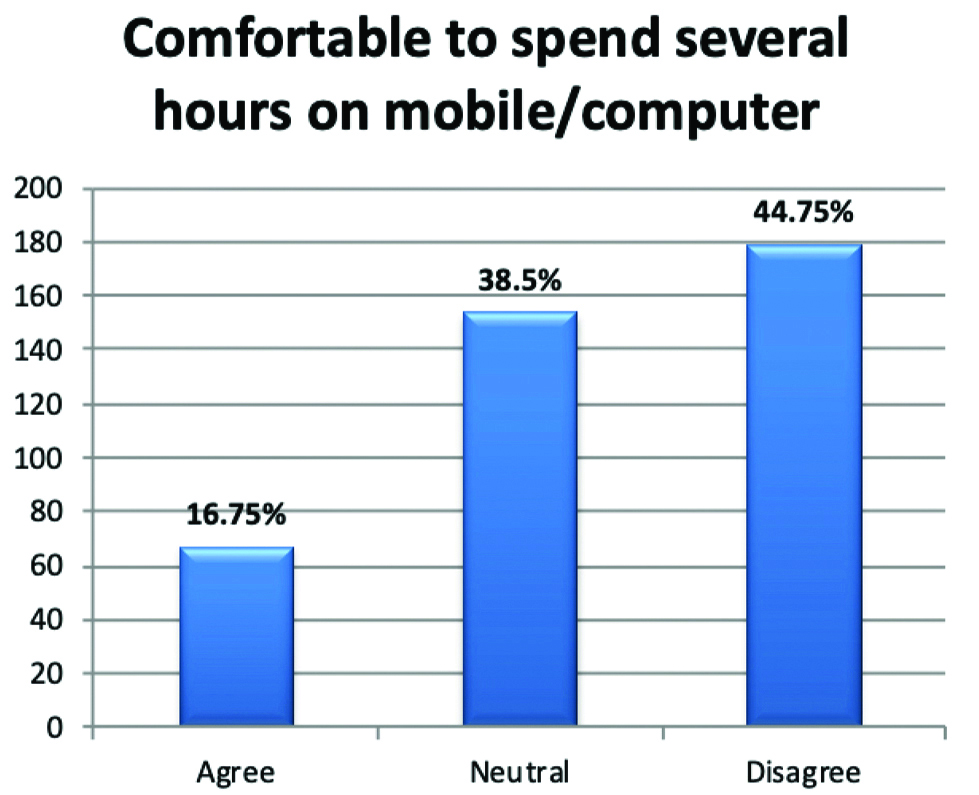
Students faced some issues during online classes; 37.75% faced issues because they belonged to rural or other nonconnectivity areas, 22.25% were unfamiliar with latest online classroom technology, 34.75% related to course understanding, 24.75 related to computer technology [Table/Fig-7].
Frequency percentage of issues student facing during online classes.
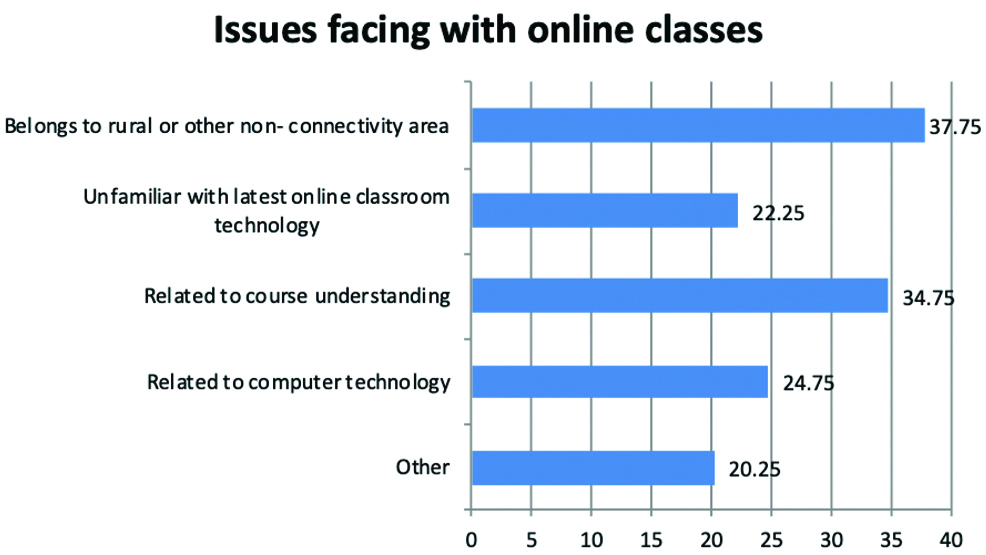
When asked whether after end of the lockdown can online teaching to be adopted as future replacement of current teaching Pedagogy the data analysis found that 16% students agreed, 3.5% strongly agreed, 26.75% disagreed, 22.75% strongly disagreed and 31% were neutral to adopt online teaching pedagogy in future which is commonly used in current scenario due to COVID-19 pandemic lockdown [Table/Fig-8].
Frequency distribution of views for future perception about online teaching.
| Can online teaching to be adopted as future replacement of current teaching Pedagogy? | n | % |
|---|
| Agree | 64 | 16 |
| Neutral | 124 | 31 |
| Disagree | 107 | 26.75 |
| Strongly agree | 14 | 3.5 |
| Strongly disagree | 91 | 22.75 |
| Total | 400 | 100 |
Discussion
In March 2020, novel coronavirus escalated into a global pandemic and schools, colleges, universities, and other educational institution all over the world made the difficult decision to shut their doors to reduce the spread of virus among the young and adult population. And then educational institutes adopted online lecture delivery mode to keep moving the student’s educational growth. Online teaching is not a new mode of delivery in India. Since, many years it has been used for distance learning. Online mode made the teaching- learning process flexible and easy. But, it has some disadvantages too. So, the current study was conducted to analyse the students choice and thinking about online teaching.
In the current study, 400 students (Physiotherapy, BAMS, pharmacy and nursing) filled the questionnaire and submitted their response. Out of 400 students; 157 (39.25%) were males and 243 (60.75%) were females. When asked about the student’s perception regarding online classes or e-learning during lockdown, 221 (55.25%) students opined that they liked studying through online classes whereas 179 (44.75%) did not like e-learning. Jena PK conducted a study on online learning during lockdown period for COVID-19 in India and found that online learning is the best platform to keep learners/educators engaged and safe by maintaining social distancing in Covid-19. The author also suggested that government/educational institutions should adopt the policy to provide free internet and free digital gadgets to all learners in order to encourage online learning [17]. In present study, when Students asked about perception regarding online classes; 41% responded that dynamic knowledge was enhanced by online platform while 59% did not agree to the same.
Adnan M and Anwar K conducted a study with 126 students receiving higher education to examine their attitudes towards compulsory digital and distance learning university courses amid Coronavirus (COVID-19) pandemic and found that online learning cannot produce desired results in underdeveloped countries, where most of students are unable to access the internet due to technical as well as monetary issues. There were some other issues highlighted by the students such as face-to-face interaction with the instructor was missing, response time and absence of socialisation offered by traditional classroom teaching [18]. Another study found the same results that lack of access to internet facilities, lack of proper interaction and contact with students and instructors and ineffective technology were among the major challenges faced by students. The sudden shift from traditional classrooms and face-to-face learning to online learning has resulted in a completely different learning experience for students. Most students from underdeveloped areas do not have access to high speed or reliable internet services and are thus struggling with online learning [19].
Lall S and Singh N conducted a study on 200 students and they found that maximum number of students not in favour of studying through online classes [9]. These finding are similar to the present study as 90.5% students thought that classroom teaching was an effective platform for better learning while very least (9.5%) selected online teaching, it may be due to some drawbacks like no practical, network issue among other reasons.
Limitation(s)
Small sample size, student centric study and involvement of limited number of universities were some of the limitations of this study. As the study population was comprised of students included from four universities, the inclusion of faculty opinion regarding online classes and inclusion of other universities might be helpful in understanding the issues faced by students and instructors regarding e-learning.
Conclusion(s)
The present study revealed that although the students liked online classes, they were not much interested in continuing the same way after the lockdown. They felt that classroom teaching was more effective than online because of struggles due to issues related to topic understanding, net connectivity, and lack of practical classes and/or demonstrations. They also felt it was more difficult to spend such a long time in front of mobiles and computers. So, quality of online education is a critical issue which needs be addressed properly and timely, in order to make improvements and increase its acceptability amongst students. For generalisability, a survey on larger sample size should be conducted across the province or country.